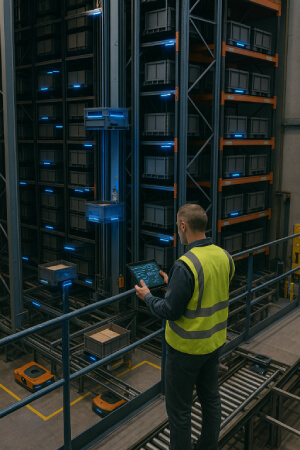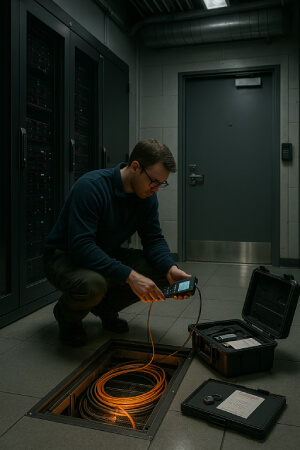The pace of technological change rarely announces itself. It gathers in the background, reshaping how companies think long before anyone realises the shift has begun. What looked experimental a few years ago now sits at the centre of everyday work. Automation takes over the dull parts of operations, data guides decisions that once depended on gut instinct, and digital systems tie markets together so tightly that geography matters less than it once did. The companies rising from this environment don’t treat technology as an accessory. They build around it, grow through it, and adapt to patterns that only become clear after they’ve already taken hold.
The Changing Face of Automation

How Automation Refines Everyday Work
When repetitive tasks fall away, teams regain the attention they lost to routine. Customer service agents focus on complicated cases instead of chasing status updates. Operations managers read patterns instead of drowning in spreadsheets. Even smaller organisations, once too stretched to invest in sophisticated tools, start operating with a precision that used to belong only to enterprise-level companies. The real story isn’t speed; it’s attention. Automation returns it to the areas that matter.
The Shift From Tools to Strategy
What began as tactical adoption has matured into strategic thinking. Leadership teams now ask a different set of questions: where automation changes the nature of the business, how it alters customer expectations, and what happens when a workflow becomes more software-driven than human-mediated. Decisions once made at the department level now reach the boardroom, because the wrong automation choice can ripple through the entire organisation. Companies that treat these systems as long-term infrastructure adjust more smoothly than those who chase short-term convenience.
The Digital-First Logic Behind Modern Industries
Digital-first used to be a label that set certain companies apart. Now it frames how entire industries behave. The assumption that processes should be physical by default has faded. Digital environments host early prototypes, early marketing efforts, early customer contact, and, more often than not, early revenue. Even companies rooted in physical operations build their internal structure around digital systems.
The Expansion of Digital Workflows
A construction firm planning a complex project begins in a digital model, long before a team arrives on site. A retailer experiments with pricing and layout inside simulations that mirror customer behaviour. A manufacturing line becomes easier to maintain when digital twins run in parallel, reflecting every small shift in equipment health. These aren’t special cases. They’re the new baseline, showing how digital systems influence industries that once felt stubbornly physical.
The Cultural Adjustment Inside Digital-First Teams
Digital-first thinking reshapes company culture as much as it reshapes operations. Teams become accustomed to working across time zones, to sharing context through dashboards rather than hallways, and to decision cycles that rely on real-time input rather than scheduled meetings. The rhythm of the organisation changes. Some find it liberating. Others take time to adapt. But once the shift settles, companies operate with a clarity they didn’t have before, simply because information flows differently.
Data-Driven Decision-Making as Standard Practice
Data has transitioned from a valuable resource into the backbone of modern decision-making. Companies build products, plan growth, and evaluate performance with a level of insight that earlier generations of businesses couldn’t imagine. What matters now is not the quantity of data collected but how effectively teams interpret it, question it, and use it to shape the future rather than merely explain the past.
The Role of Data in Predicting Movement
Forecasts now carry more weight because they evolve continuously instead of arriving once a quarter. Supply chains adjust before delays escalate. Marketing teams spot behavioural shifts earlier. Product teams notice when interest in a feature drops, rather than guess why customers lose interest. This constant stream of information helps companies navigate uncertainty with slightly steadier footing, even when the market swings without warning.
Building Transparency Around Data Use
Although data allows precision, it also raises expectations around openness. Employees expect to know how performance metrics work. Customers expect clarity about what’s collected and why. Companies that communicate these boundaries earn trust; those that hide behind vague language fall into suspicion faster than they anticipate. Successful data-driven cultures build habits around interpretation, critique, and accountability instead of treating data as an unquestionable source of authority.
Global Connectivity and Its New Responsibilities

Global connectivity isn’t a future idea, it has already reshaped how companies operate. Businesses grow faster across borders, consumers move between platforms with no concern for geography, and teams collaborate as if distance carried no weight at all. With this expansion comes a new kind of responsibility: understanding how quickly influence travels and how fragile certain systems become when everything connects.
The New Scale of Market Reach
A company can start in one city and attract interest from five continents within weeks. Early adopters come from unexpected regions. Partnerships form across unfamiliar regulatory environments. This speed brings opportunity, but it also demands adaptability. Teams must understand cultural nuance, navigate international hiring practices, and prepare for demand spikes that ignore traditional expansion timelines. Growth arrives faster than infrastructure, and companies learn to catch up rather than direct the pace.
The Impact of Interconnected Systems
Connectivity brings interdependence. A supply chain issue in one country disrupts inventory in another. A security flaw in a widely used tool spreads across thousands of organisations. A policy change in one government reshapes data requirements for companies worldwide. The businesses that survive these shifts don’t simply react, they design for uncertainty, knowing that the risks attached to global connection never completely disappear.
The Role of Hybrid Intelligence in Shaping Work
Artificial intelligence has moved past novelty. It has become a quiet partner embedded in day-to-day operations. But the companies that use it effectively recognise that AI works best alongside human judgment, not in place of it. Hybrid intelligence, where software handles scale and humans handle nuance, forms the core of many modern workflows.
The Balance Between Machine Insight and Human Interpretation
AI excels at identifying patterns too subtle or too vast for human attention. But it still requires interpretation. A healthcare team reading predictions about patient risk knows the numbers tell part of the story, not the entire picture. A financial analyst reviewing algorithmic insights about market volatility still weighs experience before making a call. This pairing creates stability: machines extend human capability, and humans give meaning to the machine’s findings.
The Practical Challenge of Integration
Introducing AI into a workflow is less about software installation and more about adjusting behaviour. Employees need training that reflects real scenarios rather than generic instruction. Teams must understand the limits of the system to avoid overreliance. Leaders need to articulate clearly where AI should take the lead and where it should step back. The companies that succeed do so because they build understanding, not just infrastructure.
Security as the Unshakeable Foundation

The focus of security has shifted from a tick in a box to a philosophy that influences all levels of an organisation. Given the centrality of technology to their operations, business risks run deep. This time around, breaches no longer stake their claims on data alone but more on trust, continuity, and the long-term viability thereof. Companies, thus, assume that vulnerabilities are present regardless of the apparent stability in their systems.
The Evolution of Threats
The security threats have grown more sophisticated because the systems they target have grown more complex. Attacks hide in supply-chain tools. Compromised credentials penetrate through holes in remote access setups. Cloud misconfigurations enable attackers undetected access into systems until harm befalls the situation. Security teams have advanced from protecting one perimeter to defending an ecosystem.
Building a Security Mindset Across Teams
Widen the accountability level and security will grow. The chattel of competing discussions on security from developers treats implementation and architecture in the form of code, with a different opinion from operations that quite seem to get in the door of access control. Information handling, being an axiom, is established within an organization. It instills in our organization that constant reinforcement and protocol function as the core components toward building a security culture and not just the recurrent sign of the law. In a strange scenario; while doing a security culture, you will see quite a few beats. However, an incident is least expected to occur.
Resilience as the Real Competitive Edge
Whenever technology gets more deeply integrated into operations, companies that stand apart aren’t so much those with the flashest kit, but the ones that contrive to remain unfazed by disruption, as systems fail, supply chains crack, and digital platforms metamorphose overnight. Being prepared ahead of time for such swings is inculcated by firms inside a self-assurance because they already have alternate routes and have stress tested their assumptions. Resilience expresses itself in technical architecture but also leadership traits and team culture. It operationalises the chaos and uncertainty, making it a manageable affair, not letting any panic seep in during the time when they need to adapt when other companies are all haphazard.
Preparing for the Next Decade of Technological Evolution
Future waves of disruptive corporate success will not have innovation as their sole trait. They will come to be identified with the choices these companies will make in the backdrop of as technogy transforms every part of business. Insights from data will deepen, automation will continue to evolve, interconnections will envelope its ever space, AI swell blend into the fabric of human effort without any visible demarcation, and security will be cast over every deciding point so that everything is assured at every end.
Organisations that reconfigure effectively in these circumstances often have one big weakness, a known presence for some, call it a demerit for routines. They encourage building processes that evolve instead of sticking rigidly to normal order. They challenge the notions that the organisation needs to test and revise. Such organisations must let a team of workers challenge the well-established ways of assembling workflows without apprehending a disturbance to the usual practises. Rather than seeing adaptability as an asset, consider making it the organisation's distinctive way of enactivating and practice something vital to the strategy.
Dive deeper
💸 In Canada, success is punished — not rewarded.
— SandraCobena (@SandraCobena_) October 3, 2025
Entrepreneurs face excessive taxes, red tape, and barriers that drive investment south.
We should be incentivizing creation, not crushing it.#cdnpoli pic.twitter.com/G5XMzYFU7B
Canada introduced an innovation visa so entrepreneurs could move to Canada and start companies.
— Crémieux (@cremieuxrecueil) May 4, 2024
That led to a 69% increase in the likelihood U.S.-based immigrants would make startups in Canada. pic.twitter.com/AVsgP2M8G9